What Eats A Moose?
Categories
- Accipitridae (1)
- Acrididae (1)
- Algae (2)
- Alligatoridae (1)
- Amoebidae (1)
- Amphibians (3)
- Anatidae (1)
- Anguillidae (1)
- Arachnids (2)
- Bears (2)
- Big Cats (3)
- Birds (13)
- Bovidae (5)
- Bufonidae (1)
- Camelids (1)
- Cameras (1)
- Canines (13)
- Caridea (1)
- Carnivora (10)
- Castoridae (1)
- Cats (5)
- Cebidae (1)
- Cephalopod (1)
- Cervidae (2)
- Cetacean (1)
- Chondrichthyes (1)
- Crocodilia (2)
- Crustaceans (4)
- Culicidae (1)
- Cyaneidae (1)
- Dasypodidae (1)
- Dasyurids (1)
- Deer (1)
- Delphinidae (1)
- Desktop (1)
- Didelphidae (1)
- Dinosaurs (1)
- Dogs (13)
- Dolphins (2)
- Echinoderms (1)
- Education (10)
- Elephantidae (1)
- Equine (1)
- Erethizontidae (1)
- Erinaceidae (1)
- Farming (1)
- Felidae (5)
- Fish (5)
- Food Chain (31)
- Food Web (2)
- Formicidae (1)
- Frugivore (1)
- Gaming (1)
- Gastropods (1)
- Giraffids (1)
- Great Apes (2)
- Health Conditions (3)
- Herbivore (4)
- Hi-Fi (1)
- Hippopotamidae (1)
- Hominidae (1)
- Insects (10)
- Invertebrates (2)
- Keyboards (1)
- Laptops (1)
- Leporidae (1)
- Mammals (23)
- Marsupials (4)
- Mephitidae (1)
- Microchiroptera (1)
- Mollusks (2)
- Mongoose (1)
- Muridae (1)
- Nocturnal Animals (1)
- Odobenidae (1)
- Omnivore (2)
- Phasianidae (1)
- Phocidae (1)
- Plankton (1)
- Plants (2)
- Primate (1)
- Ranidae (1)
- Reptiles (7)
- Rhinocerotidae (1)
- Rodents (5)
- Salamandridae (1)
- Scarabaeidae (1)
- Sciuridae (2)
- Sharks (1)
- Shellfish (1)
- Sound (1)
- Spheniscidae (1)
- Suidae (1)
- Superfamily Papilionoidea (1)
- Theraphosidae (1)
- What Eats (5)
The moose is the largest member of the deer family. It is such a large herbivore, or plant-eating animal, that it only has two predators or natural enemies.
Wolves often attack, kill and eat moose. But usually it takes many wolves to kill a moose.
Grizzly bears also eat moose. Grizzlies prefer to eat young, or baby moose, because they are easier to catch and kill. But these bears are powerful enough to kill a full-grown moose when they need to.
What does a moose eat? Moose are browsers, which means they eat a variety of leaves, twigs and other plant material.
Table of Contents
Toggle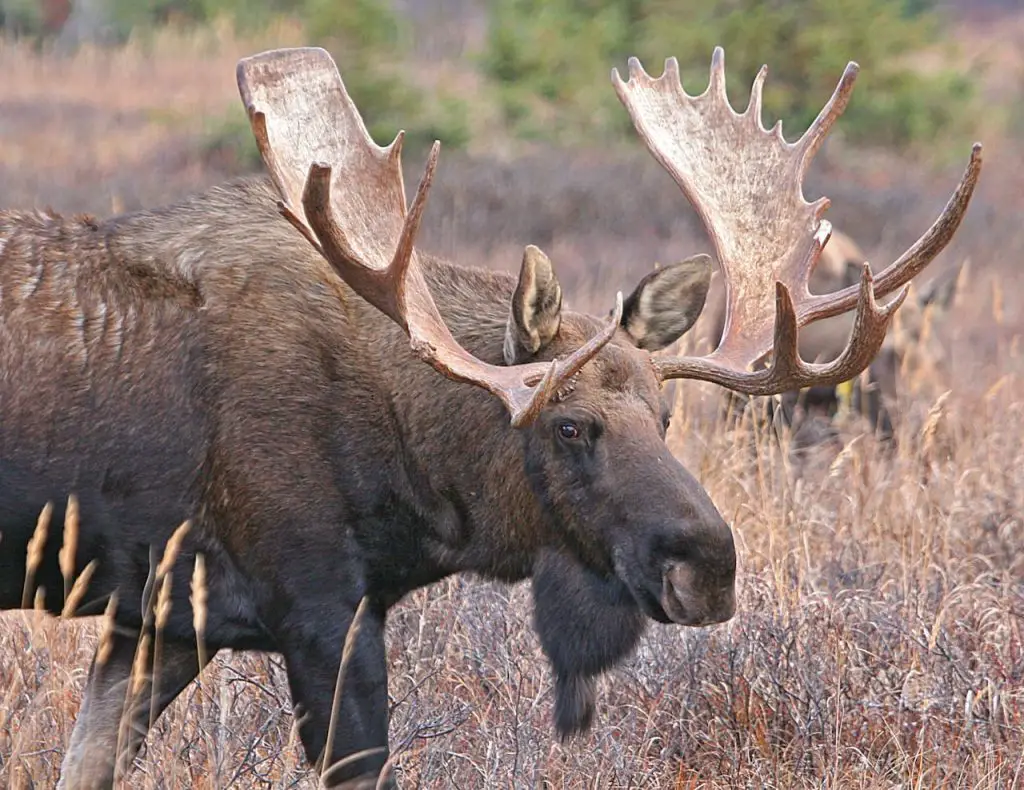
Introduction
Alces alces is the scientific name for the moose, a vast, strong ruminant that inhabits the tundra and forests of North America and Eurasia. The enormous deer species known as moose is vital to the environments in which they inhabit. Moose are strong and large animals, yet they are not immune to harm. The moose is a herbivore which means they mostly eat plants.
Moose mostly eat aquatic plants, including pondweed, sedges, grasses, horsetails, branches, buds, and leaves from willow and birch trees. Since there is less water vegetation in the winter, moose also eat a lot of terrestrial flora.
Several powerful predators hunt them down. The predators of moose, their hunting techniques, and the ecological dynamics of these encounters in the wild will all be covered in this article.
Predators Of Moose
1. Wolves
Canis lupus, a predator, is well-known for its social structure, intelligence, and prowess in hunting. In regions where their habitats overlap, wolves play a significant role as predators of the gigantic deer species known as moose. In wilderness regions of North America, the dynamics of the ecosystem are significantly shaped by the predator-prey interaction.
Wolves use their cooperation, endurance, and cunning to their advantage when hunting moose in organized groups. Even though moose are substantial herbivores, wolves are skilled at preying on weaker members of the community, such as young animals or elderly or sick moose. Through tenacity and teamwork, pack members pursue, isolate, and ultimately bring down their prey.
Wolves hunt moose with great success in the winter when the thick layer of snow makes it harder for the animals to avoid predators. Moose may be tracked by their smell trails, or they can ambush them in places where they are most likely to congregate, such as deep woodlands or riverbanks.
Wolves promptly devour a downed moose, usually beginning with the internal organs and soft tissues. Since a lone moose may sustain a whole wolf pack for many days, moose hunts are essential to the survival of these top predators, particularly in the brutal winter months when food sources are limited.
The ecological effects of wolves preying on moose are extensive. It serves as a crucial food supply for wolves and other scavengers and aids in regulating moose numbers, limiting overgrazing and habitat damage. This predator-prey interaction supports ecosystems’ general health and balance in boreal forests and other wilderness places where moose and wolves coexist.
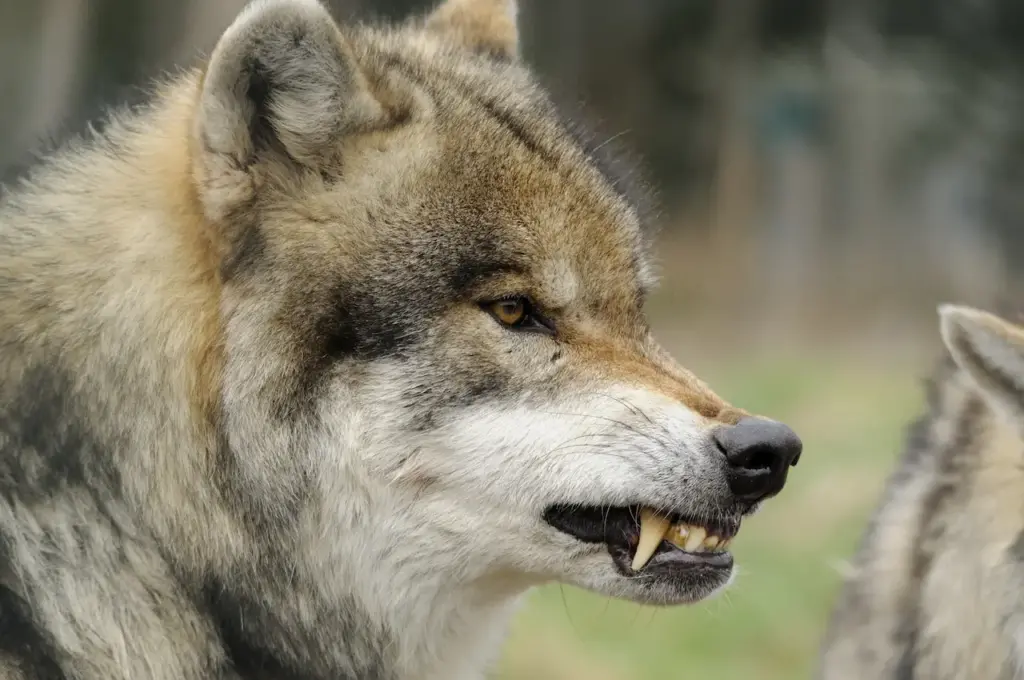
Angry Wolf What Eats A Wolf
2. Bears
In areas where their habitats overlap, bears, including grizzly bears (Ursus arctos horribilis) and black bears (Ursus americanus), prey on moose on occasion. Although their primary food sources include plants, berries, insects, and small animals, bears may sometimes take down larger prey, such as mature moose.
Bears usually prey on newborn moose calves or weaker ones, including those hurt or stranded in heavy snow. Bears can kill moose with their great strength and strong jaws, and they frequently eat the corpse over several days.
Even though bears prey on moose less frequently than wolves, it is still a serious concern, especially for those more susceptible.
The interactions between bears and moose highlight the intricate links between predators and prey in North American ecosystems. Bears partially regulate moose numbers, particularly in periods of plenty when few alternative food sources exist.
Biodynamics provides a base for relationships between bears and moose and should be considered in conservation activities aiming at the sustainable protection of those species.
Predator and prey populations must remain healthy to avoid confrontations with humans, conserve habitat, and implement sustainable management techniques.
We can guarantee the long-term survival of bear and moose populations in their native environments by comprehending and regulating these connections.
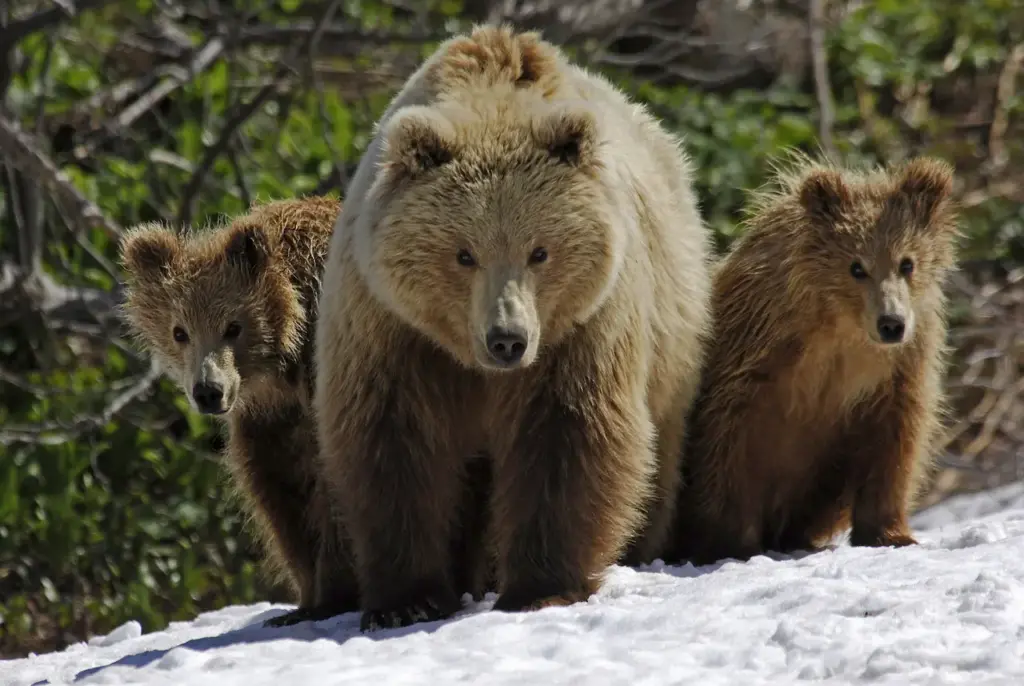
Three Bears on Snowy Field
3. Mountain Lions
Pumas or better known as a mountain lion or cougars, are the top predator that surprisingly roams through meadows, mountains, and forests in North America. Even though their main prey is smaller animals like deer, elk, or caribou, they have also been repeatedly observed predating on moose, particularly moose lambs or moose that were injured or sick.
Mountain lions use stealth and ambush techniques to capture their food, frequently chasing solitary or gullible animals. Even though moose are large and powerful animals, a mountain lion’s surprise assault can be fatal, especially for young animals or lone individuals.
Although moose and mountain lion interactions are not every day, they remind these top predators of their versatility and opportunism.
In regions where other predators, like wolves, are rare, mountain lions help control the number of moose. Mountain lions help keep moose numbers and their habitats in a healthy balance by preying on those more susceptible.
Furthermore, the predation of mountain lions supplies essential food for smaller predators and scavengers like bears, enhancing the richness of the environments in which moose and mountain lions coexist.
Ecological equilibrium in North American ecosystems depends on conservation initiatives that protect mountain lions and their habitats.
Preserving habitat, reducing human-wildlife conflicts, and putting policies in place to safeguard predators and prey are crucial for maintaining mountain lions’ long-term survival and the sustainability of their relationships with moose and other species in their ecosystems.
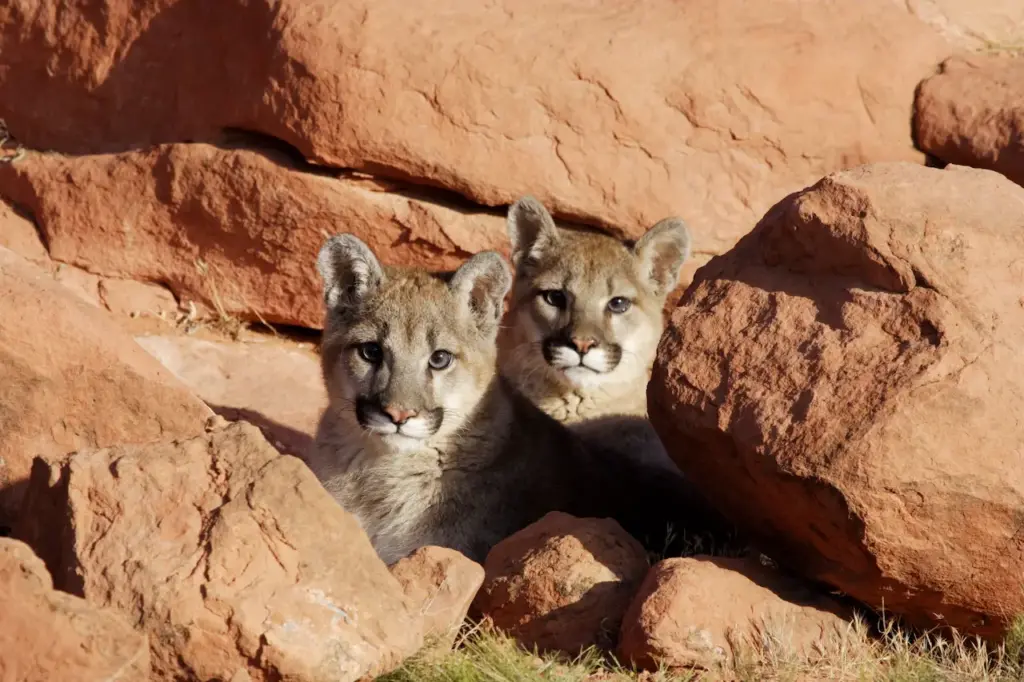
Mountain Lions
4. Siberian Tigers
The giant animal in the world, Siberian tigers (Panthera tigris altaica), often called Amur tigers, are the predators in their natural habitats, which include the deep forests of the Russian Far East.
Although Siberian tigers mostly hunt ungulates like deer and wild boar and smaller prey like rabbits, they have also been observed killing moose when the chance presents itself.
Because of their size and power, moose pose a dangerous threat to Siberian tigers. Since young, ill, or injured moose are more accessible to take down, tigers usually prey on them.
Due to their extraordinary stealth and ambush skills, Siberian tigers approach moose covertly before making a surprise attack. A determined tiger may overcome a moose with its strong jaws and claws, even with its formidable defenses.
Because Siberian tigers and moose have different ecological preferences and behavioral patterns, encounters between the two species are somewhat uncommon. But they also highlight how versatile and cunning these amazing predators are.
The fragile balance of ecosystems in the Russian Far East depends on conservation initiatives that target the protection of Siberian tigers and moose. It can be guaranteed the survival of these iconic species and the integrity of their natural habitats by protecting habitats and reducing human-wildlife conflicts.
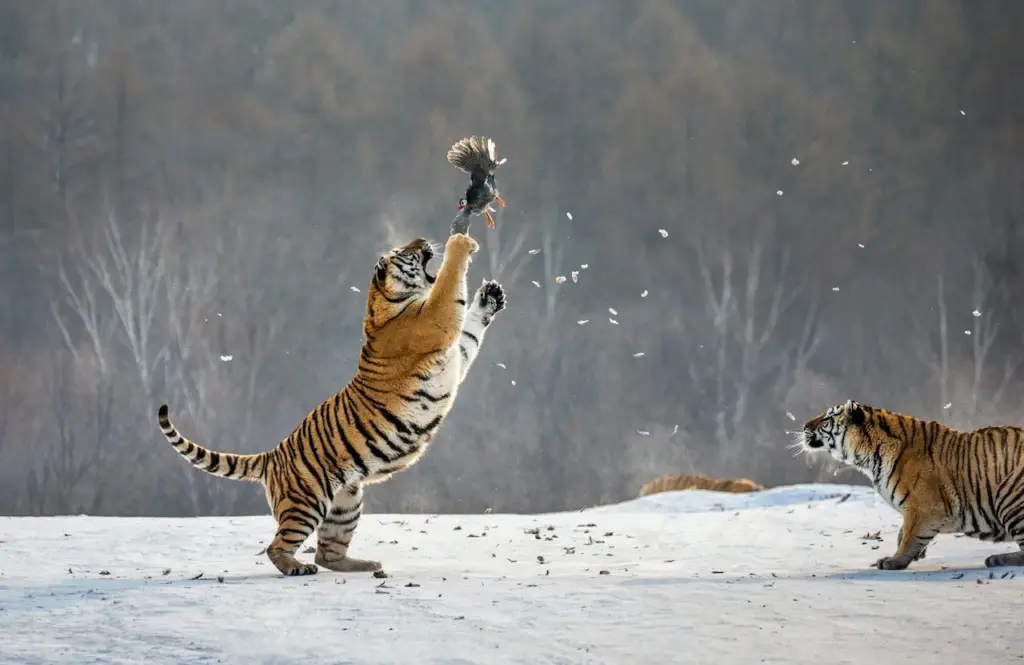
Siberian Tigers In The Snow Catching A Bird
Final Words
Finally, the intricate connection of Siberian tigers, wolves, bears, and other top predators to moose reflects the functioning makeup of ecosystems.
Yet, despite their vast size, they are also prey to predators, serving as a natural means of keeping the population at an appropriate level so that the ecosystem’s equilibrium is maintained. The survival and well-being of northern wildlife resources are based on implementing conservation programs to hold moose and predators.
We can protect moose survival and the existence of both their predators and prey by decreasing human influence, combining societies, and using sustainable management techniques. In addition, maintaining and enhancing the predator-prey link so the ecosystem will be more resilient and biodiverse is very important.
Through collaborations on conservation actions, we can collectively achieve the existence of moose and predators living in harmony, thus ensuring the future of the wilderness for generations.
